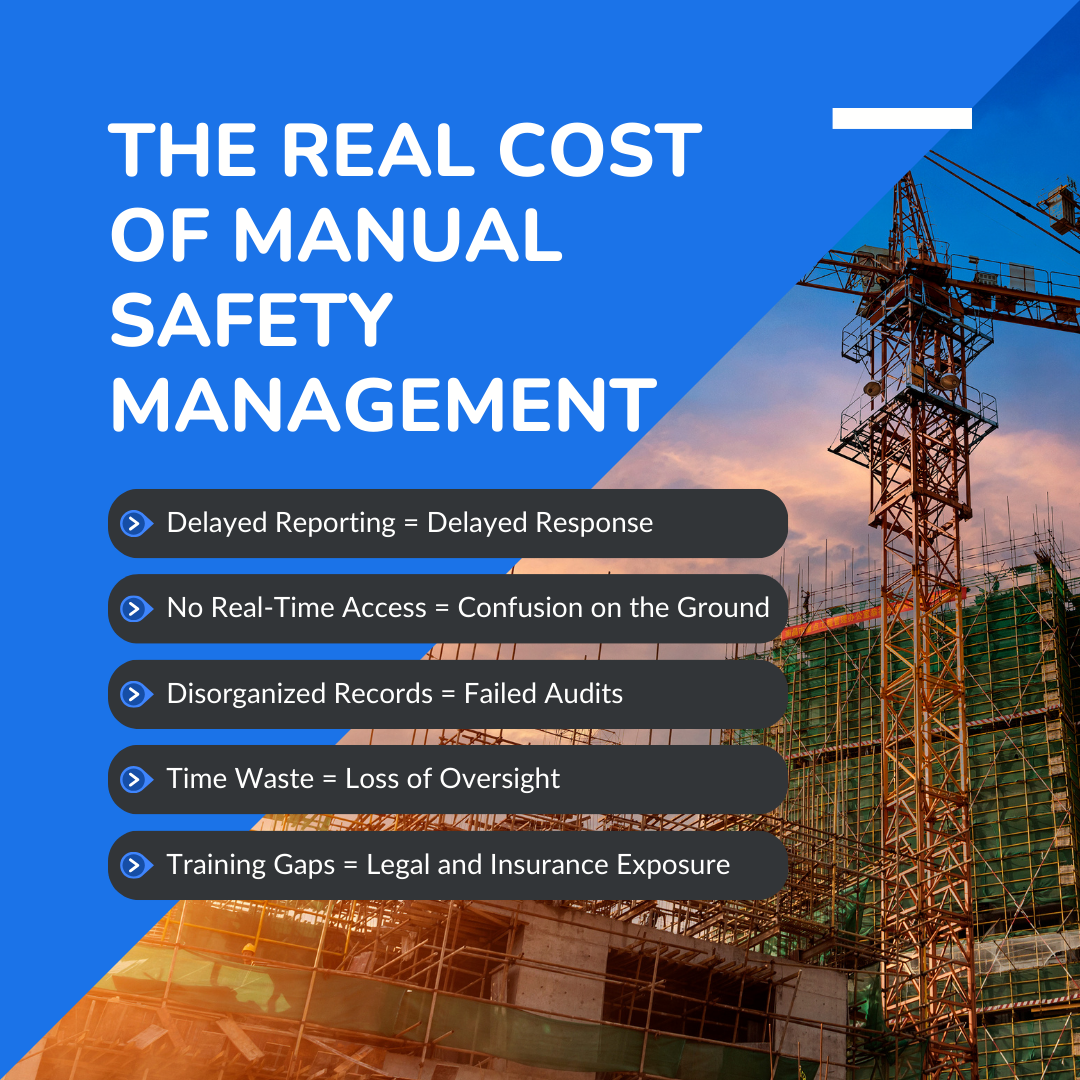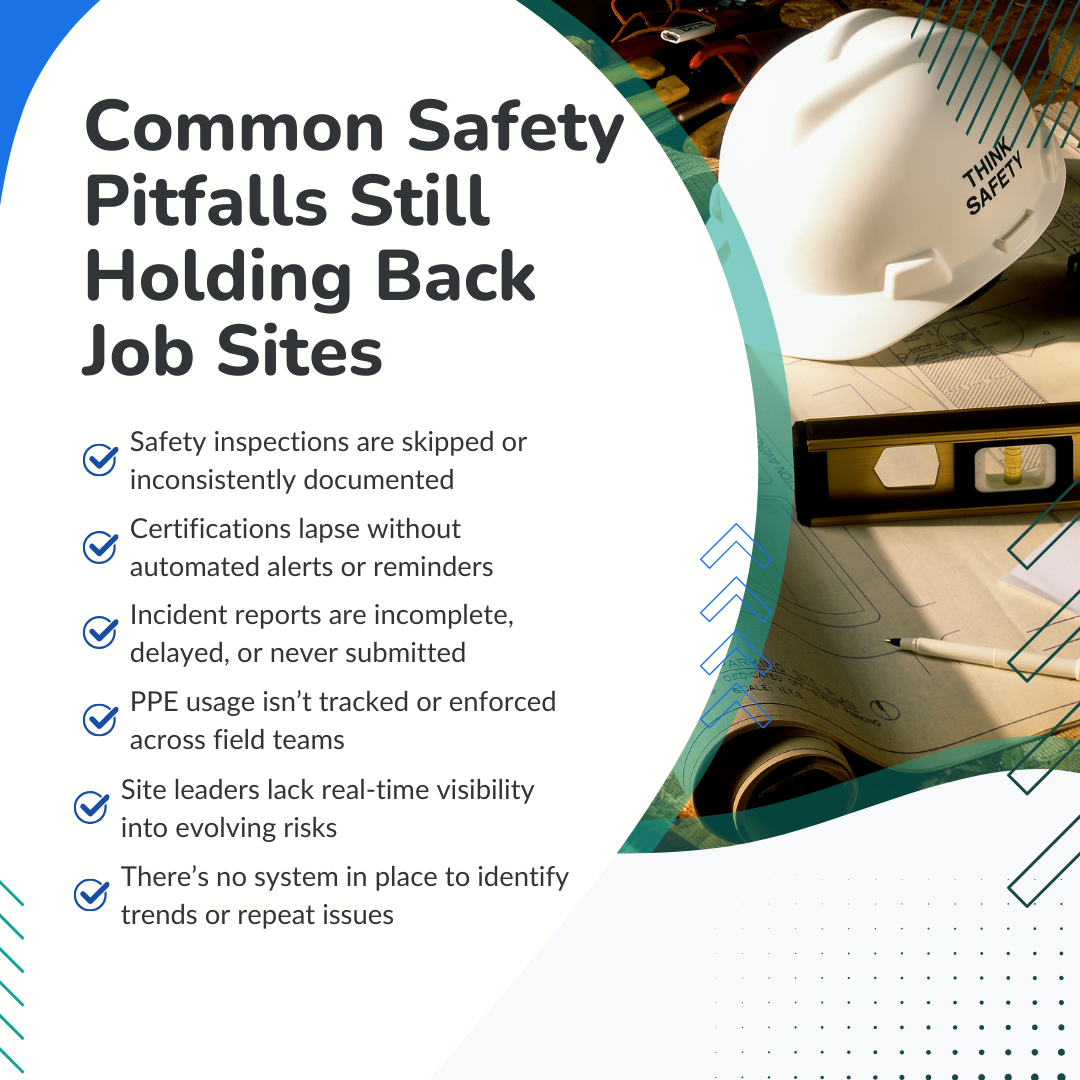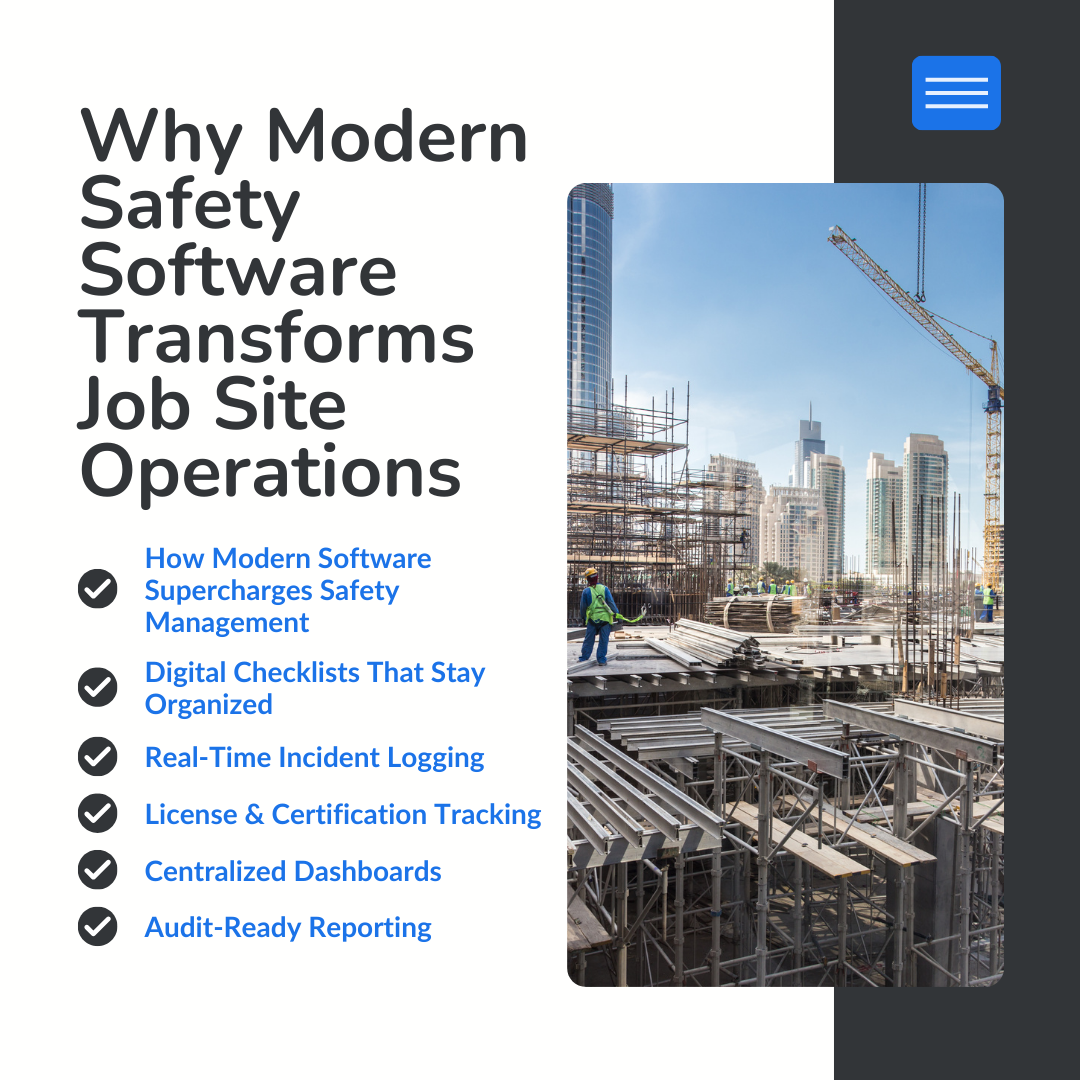Let’s face it, keeping a construction site safe in 2025 isn’t easy. Projects are bigger, timelines are tighter, and safety regulations aren’t getting any looser.
And if you’re still relying on paper checklists or scattered spreadsheets, you’re not just behind, you’re risking delays, fines, and accidents.
That’s where construction safety software steps in.
Designed for real job sites, not office desks, this tech helps you log incidents instantly, track certifications automatically, and stay audit-ready without the last-minute scramble.
It’s not just about compliance; it’s about making safety part of how you build every day.
In this blog, we’ll break down how digital tools are helping site supervisors, safety officers, and contractors work smarter, respond faster, and lead safer projects.
Managing Construction Safety & Compliance with the Right Software
Today’s construction companies don’t just build; they manage complex teams, tight deadlines, and increasingly strict safety standards. That’s why more site supervisors and safety officers are turning to construction safety software to stay on top of it all.
These platforms handle everything from incident reports and toolbox talks to real-time safety data and compliance tracking, all in one place.
You get better visibility into workplace hazards, instant access to safety inspections, alerts for missed safety meetings, and a full view of your safety metrics. Most importantly, you’re not reacting to problems; you’re preventing them.
The result? Safer job sites, more efficient projects, fewer delays, and a clear path to keeping stakeholders informed and audits stress-free, all while protecting your field teams and bottom line.
Key Takeaways:
- Construction safety software centralizes incident reporting, inspections, and compliance for safer job sites.
- Real-time safety data and automated workflows help field teams identify hazards and mitigate risks proactively.
- Mobile-first tools ensure safety meetings, toolbox talks, and certifications are tracked and up-to-date.
- Audit-ready dashboards and metrics keep stakeholders informed and streamline regulatory compliance across projects.
The Construction Landscape in 2025: Fast, High-Pressure, and Risk‑Averse
Construction in 2025 is nothing if not fast-paced and unforgiving. Projects are growing larger, deadlines are tighter, and safety standards are tougher than ever.
Agencies like OSHA, BOCW, and ISO 45001 now enforce regulations that aren’t optional, and clients demand complete transparency and regulatory compliance.
Safety still tops the risk list: In fact, there were 5,283 fatal work injuries in 2023, according to the Occupational Safety and Health Administration. Many of these incidents are preventable with the right systems in place, underscoring the critical need for digital tools on-site.
Meanwhile, the industry continues to face frequent workplace hazards, falls, and injuries that threaten both people and project timelines.
Traditional, manual safety programs that used paper forms and offline registers can’t scale with today’s demand. They have slow response times, blind spots in incident reporting, and leave compliance gaps that cost time, money, and reputation.
Construction safety software changes all this. A mobile-first platform lets you log real-time data, manage toolbox talks, track certifications, and spot trends before they turn into problems, helping you mitigate risks, protect your teams, and keep projects moving smoothly.
Explore Future Trends in Construction Estimating Software Development.
The Real Cost of Manual Safety Management

Manual safety processes might feel familiar, but in today’s construction environment, they’re quietly costing you time, money, and control. Without the right construction safety software, you're left playing catch-up instead of staying ahead. Here’s how:
1. Delayed Reporting = Delayed Response
When hazards aren’t reported in real time, incidents escalate. Delays in incident reporting can shut down entire job sites, risking both your workers and your reputation.
2. No Real-Time Access = Confusion on the Ground
Field teams need instant access to safety data, checklists, and credentials. Without mobile-friendly tools, workplace safety becomes guesswork.
3. Disorganized Records = Failed Audits
Spreadsheets and paper logs make it hard to retrieve safety metrics and safety inspections under pressure. Auditors expect traceability, and manual systems often fall short.
4. Time Waste = Loss of Oversight
Supervisors spend hours following up instead of enforcing safety protocols. That’s valuable time lost from proactive safety management.
5. Training Gaps = Legal and Insurance Exposure
Missed toolbox talks or expired certifications can lead to non-compliance, legal liability, and increased insurance premiums.
With the right safety management software, your team gets one platform to manage everything, identify trends, send alerts, report incidents, and keep field workers protected with real-time visibility.
Common Safety Pitfalls Still Holding Back Job Sites

Even the most experienced construction companies can fall victim to preventable safety lapses, especially when relying on outdated, manual systems.
Without the right safety management software, blind spots persist, and small issues snowball into costly problems.
Here are some of the most common pitfalls still affecting today’s job sites:
- Safety inspections are skipped or inconsistently documented
- Certifications lapse without automated alerts or reminders
- Incident reports are incomplete, delayed, or never submitted
- PPE usage isn’t tracked or enforced across field teams
- Site leaders lack real-time visibility into evolving risks
- There’s no system in place to identify trends or repeat issues
These gaps not only compromise workplace safety but also leave your business vulnerable to compliance failures, legal exposure, and reputational damage.
The solution? Centralized, real-time construction safety software that helps you stay informed, compliant, and in control before issues arise.
Here's How to Overcome Labor Shortages in Construction while Maintaining Safety Standards.
How Modern Safety Software Transforms Job Site Operations

Let’s walk through how construction safety software turns everyday challenges into smooth, proactive site operations:
Digital Checklists That Stay Organized
Mobile-first forms cover everything, from PPE and scaffolding to heavy equipment inspections. Available anytime, anywhere, they keep your safety inspections timely, accurate, and collaborative.
Field teams love how this cuts paperwork and improves team productivity and agility.
Real-Time Incident Logging
Capture issues on the spot, even offline, with photos, voice notes, and corrective actions attached. This speeds up incident reporting, ensuring every incident becomes a data point in your safety rhythm.
License & Certification Tracking
Modern safety software never lets expirations slip through. Automated alerts keep certifications and training up to date, boosting regulatory compliance and minimizing legal or insurance exposure.
Centralized Dashboards
Pull together key safety metrics, inspection statuses, training progress, and incident trends site-wise, in real time. This means better visibility, smarter decision-making, and the ability to identify trends before they become risks.
Audit-Ready Reporting
Every record is traceable, timestamped, and searchable. Safety software ensures no more last-minute scrambles, just confidence that your documentation is solid when regulators or stakeholders come knocking.
What Leading Contractors Understand (and Apply)
Top-performing construction companies know something important: construction safety software isn’t just a nice-to-have tool but a competitive advantage.
- It’s more than operational support; it’s strategy. By using one platform for safety inspections, incident reporting, and safety metrics, they eliminate gaps, save time, and keep stakeholders informed from day one.
- Faster response times protect people and productivity. When a hazard is reported via mobile devices, managers act immediately, reducing downtime and protecting project success.
- Real-time data turns into real results. With safety management software, field leaders can see risks as they develop, prioritize corrective actions, and prevent small issues from becoming major incidents.
- Compliance builds trust. Consistently meeting safety standards and regulatory compliance requirements earns confidence from both clients and regulators.
- Better records mean better business. Strong workplace safety performance leads to fewer claims, lower insurance costs, and more awarded contracts.
By combining safety protocols, proactive safety meetings, and instant project data access, leading contractors stay ahead, protecting workers, delivering safer job sites, and ensuring every project moves forward without costly surprises.
Where Safety Tech Is Headed for Construction Projects
In the fast-moving world of construction projects, using the right construction safety software is no longer optional; it’s essential for workplace safety, efficiency, and project success.
From job sites to head offices, technology is transforming how construction companies handle safety protocols, safety data, and safety management.
Key trends shaping the future:
- Mobile inspections and automated incident reporting workflows – Field teams can now use mobile devices to conduct safety inspections, report incidents, and record project data in real time.
- This ensures potential hazards are flagged before work begins and corrective actions are taken immediately.
- Embedded toolbox talks and license tracking – Safety meetings, fall protection briefings, and compliance checks are built into safety management software, keeping workers aligned with safety standards.
- AI-powered analysis to identify trends – By tracking safety metrics, safety program data, and safety incidents, construction companies can spot recurring workplace hazards and mitigate risks early.
- Wearables for real-time worker monitoring – These devices capture real-time data to protect field workers, detect risks, and enhance workplace safety.
- Unified safety software platforms – One platform can manage safety inspections, incident reporting, regulatory compliance, and safety meetings while keeping all stakeholders informed from anywhere.
The impact of these advancements is clear:
- Reduce risk and save time with faster safety inspections and follow-up actions
- Improve safety management and ensure safety standards across all construction projects
- Keep stakeholders, project managers, and field teams aligned on safety protocols and compliance requirements
- Streamline data flow between the field and office for greater efficiency and regulatory compliance
- Proactively mitigate risks before they disrupt business, projects, or worker safety
If your team isn’t leveraging modern safety software and safety management tools, you’re already a step behind. Construction safety tech is no longer the future; it’s the now.
How ConstructionBase is the Best Safety Management Software

Think of ConstructionBase as your safety co-pilot that is purpose-built for real construction workflows, not just another checklist app.
> Built for the way sites work
This isn’t a one-size-fits-all form tool. It mirrors the flow of real construction. From project takeoffs to live tracking, it aligns safety with how your teams actually build and stay compliant.
> Live insights for smarter decisions
With real-time tracking and dashboards, you see exactly where risks live and what’s being done. Whether it’s safety inspections or compliance tasks, nothing slips through the cracks.
> Automated workflows that safeguard your program
From onboarding and toolbox talks to inspections and incident follow-up, ConstructionBase automates every step, so safety becomes seamlessly embedded at each touchpoint.
> Audit-ready by design
Every log, action, and corrective step is traceable and time-stamped. When auditors come knocking, your records stand up, clear, complete, and stress-free.
> Regulatory Compliance Tracking
Stay ahead of changing regulations. ConstructionBase maps tasks and inspections so nothing falls out of compliance.
> Centralized Document Control
Store and manage all safety policies, SOPs, and compliance documents in one place with version control to ensure teams always access the latest approved files.
By using construction workflows with powerful safety management and real-time project data, ConstructionBase lets you mitigate risks, protect your field workers, stay audit-ready, and keep projects moving forward with confidence.
Check out the Best Construction Management Software in 2025 for more details.
Final Word: Safety Is Now a Software Conversation
Safety isn’t just a compliance box; it’s the foundation of every successful construction project. In 2025, relying on outdated, manual processes is more than inefficient; it’s risky.
With ConstructionBase, inspections, incident reporting, and compliance aren’t chores; they’re streamlined into a proactive safety program. Real-time data, automated workflows, and audit-ready records keep your teams protected and your projects running smoothly.
With the right safety software, you’re not just meeting safety standards, you’re setting them. Lead with confidence, protect your people, and let ConstructionBase make safety your competitive edge.
About ConstructionBase
ConstructionBase streamlines every step of your build from takeoffs to tracking, so projects run smoother and safer. See how it works for your team. Explore ConstructionBase today!
FAQs
1. Which is the most popular construction software?
ConstructionBase is a leading choice for construction teams, offering safety automation, live compliance dashboards, and mobile-first workflows, all designed specifically to keep sites audit-ready and teams working efficiently.
2. What is the 20 20 20 rule in construction safety?
The 20-20-20 rule suggests workers take a 20-second break every 20 minutes by looking at something 20 feet away. It helps reduce eye strain, especially for those reviewing digital plans or operating screens on-site.
3. How much does HCSS Safety cost?
HCSS Safety pricing varies based on company size, features, and implementation needs. It’s best to contact their sales team for a personalized quote that matches your project and compliance requirements.
4. What is a construction safety program?
A construction safety program is a structured plan to prevent accidents and ensure compliance. It includes training, inspections, reporting, and emergency procedures, often supported by software like Constructionbase to streamline and automate these processes.
Have questions or need personalized advice?
Talk to an Expert Today and let our construction specialists guide you to success.







